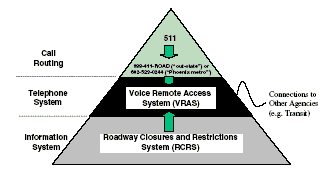
 |
||
|
|
511 Case Study Overview - Arizona511 Case Study Overview - The State of ArizonaFive government sponsored phone-based traveler information systems have been identified to be operating in Arizona. The 888-411-ROAD toll-free phone system, Voice Remote Access System (VRAS), operated by Arizona DOT (ADOT) is the most relevant in terms of near-term 511 services. The VRAS is an automated interactive voice response (IVR) system that handled over 100,000 phone calls in 2000, more than a 100% increase from 1999. The VRAS often becomes overloaded with demand during inclement weather or holiday weekends. The Roadway Closures and Restrictions System (RCRS) provides this information to the VRAS. The RCRS collects information about construction locations, traffic-related maintenance activities, weather-related road closures, and traffic incidents from various authorized agencies for both local arterial streets and urban/rural highways statewide. Presently, data is inserted from 89 locations ranging from ADOT Districts, several cities, the Highway Patrol, National Forest and Weather Services, Grand Canyon National Park as well as neighboring states. The RCRS software is available to other public agencies through a free license from Arizona DOT. 511 VisionAt least in the near-to-mid-term, Arizona DOT will continue to operate the VRAS as the gateway to traveler information in the state. The service will continue to be free to callers. Key elements of the Vision of the Arizona 511 approach are: 
Ongoing ActivitiesAn Arizona 511 Task Force has been established to coordinate the conversion of existing phone systems to 511 and facilitate their functional expansion. The Task Force identified several key issues and steps needed to roll out 511 services, with an initial focus on wireline calls. However, Qwest, the largest wireline carrier, has not been as responsive as hoped to work out the necessary technical and financial agreements to enable call routing. Lessons Learned
March 1, 2001 You may need the Adobe® Reader® to view the PDFs on this page. |
||
| Allowing Travelers to Make Better Choices |
| US DOT Home | FHWA Home | 511 Travel Information Telephone Services | Operations Home | Privacy Policy |